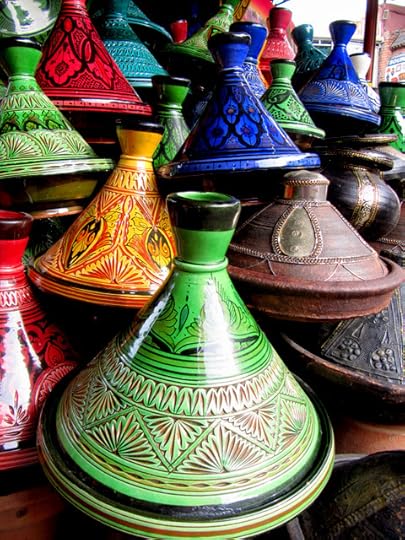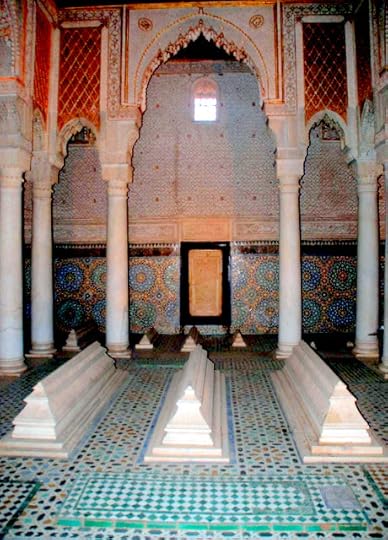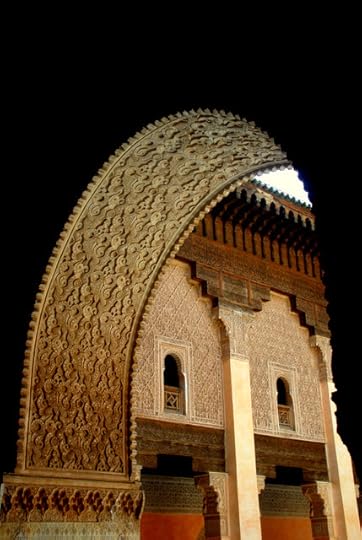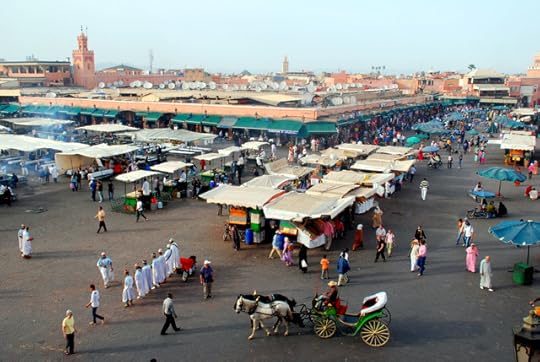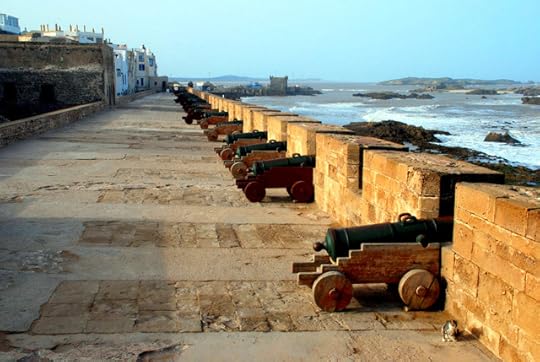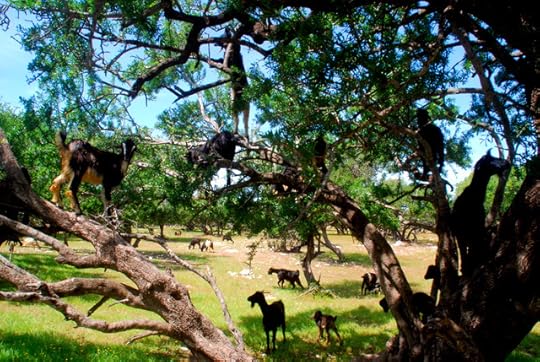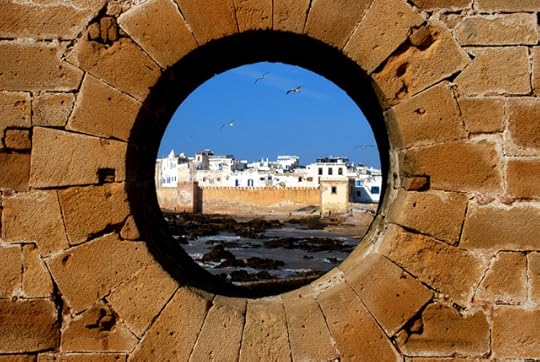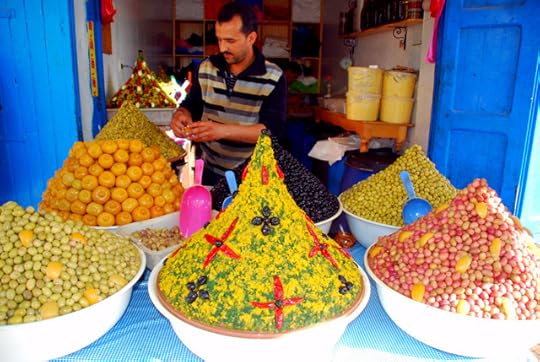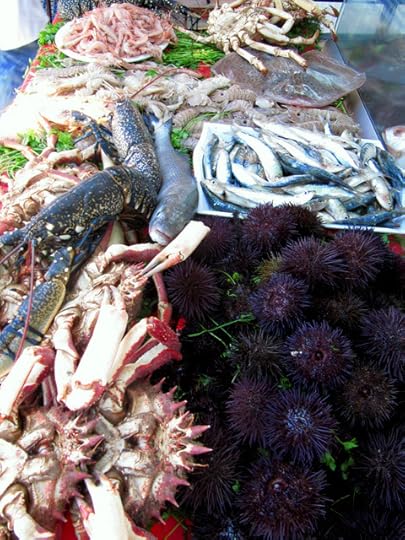Roderick Phillips's Blog, page 12
April 5, 2014
The souqs of Marrakesh, Day 250
Before Christi and I dice with death by exploring the many souqs of Marrakesh in search of potential souvenirs, we need to plan our onward travel. Our choice is to continue exploring Morocco by public transport or to join an organized tour. Public transport is cheap, slow, and the routes do not always coincide with our desired destinations. Tours are more expensive, more efficient, but involve other tourists and can be restrictive. A private tour would of course be ideal, but the associated comfort and flexibility comes with a hefty price tag.
There are plenty of tour agencies in Marrakesh offering 3-day, 2-night group tours into the Moroccan Sahara for 900D (US$110) per person departing daily. With so many hole-in-the-wall agencies offering such trips it is clear that all interested tourists will be bundled together into one group – and usually aboard the smallest vehicle possible (and in Morocco that’s saying something). All tours follow the exact same route: south-west through the High Atlas mountains, taking in the Todra and Dades Gorges, Ait Benhaddou, the Draa valley (origin of the Saadian dynasty of Moroccan kings, incidentally), and a night sleeping in the Sahara with a dawn camel safari thrown in before returning to Marrakesh. We don’t feel the need to spend another night sleeping in the Sahara or indulge in another uncomfortable camel ride (our memories from Mauritania and Mali are still fresh). We therefore talk to the owners of Hilali tours about an alternative 3-day 2-night private excursion. Actually conducting a business transaction with an Arab is not that simple. Arabs are good business people; they are thorough and very precise. This means we have to establish our exact itinerary ahead of time and stick to it – even if we find something more interesting to see or do during the tour. These wily Arabs calculate mileage and petrol costs, car rental fees, driver hire, as well as food and accommodation. I can see the wheels turning in the mind of the owner, no doubt calculating a monster profit margin. ’5600D [US$700]‘ he yells. That pretty much ends the conversation before it has even begun and both Christi and I get up to leave. Hands dart out from everywhere urging us to sit – tea is offered. The word ‘friends’ is suddenly added to the conversation and the negotiations begin in earnest.
Negotiating can be fun if both parties are willing to compromise – and we do. 3300D is the magic number, which is still more than Christi and I wanted to pay, but is no doubt less than Hilali tours were hoping for. And the driver / guide must speak English I add before shaking hands on the deal. The itinerary is hastily written up and the contract signed. We leave tomorrow.
With the time remaining to us we dive into the souqs reluctant to be parted from anymore cash, despite the bewildering array of tourist trinkets that are for sale: from tajine pots to Moroccan slippers and carpets to paintings, perfume, spices, bowls, light shades, hats, wicker baskets, olives, dried fruit, handbags, and wood carvings to name but a few. Plus there are the smooth sales pitches. It ‘s wise not to listen too closely otherwise their hypnotic voices will soon have you separated from your money. And while that souvenir may look good in Morocco, you might be scratching your head a little when you get it back home!
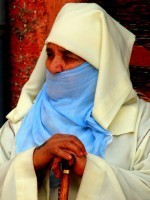

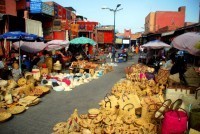
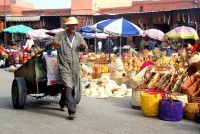


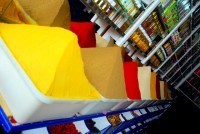
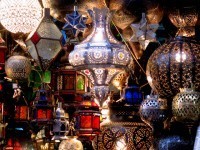

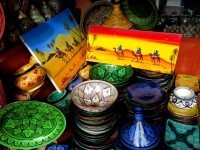
Blog post by Roderick Phillips, author of Weary Heart – a gut-wrenching tale of love and test tubes.
The post The souqs of Marrakesh, Day 250 appeared first on Roderick Phillips.
April 4, 2014
Saadian tombs, Marrakesh, Day 249
Morocco certainly encourages lazy mornings. And who wants to rush when there’s fresh croissants , OJ, and coffee and views of Djemaa el-Fna from the hotel’s roof-top terrace to linger over. Being a voyeur of Djemaa el-Fna is a lot less intense than experiencing it at ground level, although we have to run the gauntlet of sales opportunities, speeding mopeds, and confusing alleyways as we search for the southern troika of tourist destinations: Palais el-Badi, Palais de la Bahia, and the Saadian tombs.
The Palais el-Badi are an impressive collection of ruins – impressive from the perspective of their sheer size which resemble modern skyscrapers. Apparently it was a beautiful palace in its day with a large central pool, landscaped gardens, public audience rooms, private chambers for the Saadian king, Ahmad al-Mansur (who ruled Morocco between 1578-1603) not to mention suites of accommodation for visiting dignitaries. Currently the most impressive aspect are the massive storks’ nests balanced precariously on the walls and towers and the fluffy baby stork chicks that are being raised there.
Near Palais el-Badi (the Incomparable Palace) is the rather more appealing and much better preserved Palais de la Bahia (the Brilliant Palace). Much like yesterdays beautiful geometric patterns at the madersa, the walls, doors, and ceilings of the Palais de la Bahia are richly decorated. The wrought iron filigree, carvings, marbled alcoves, landscaped gardens and courtyards, not to mention the stained glass windows are all exquisite. Palais de la Bahia is actually a collection of separate buildings that were converted into palace in the late nineteenth century by Moroccan architect El Mekki on behalf of the Grand Vizier Ba Ahmed ben Moussa said Hmad (not a name that naturally trips off the tongue). The best workers and artisans in Morocco worked for six years (between 1894-1900) to create this sumptuous palace.
Finding the last of the southern tourist attractions, the Saadian tombs, is darned tricky. You’d think that a major tourist attraction would be well-signposted. Not a bit of it. Instead we rely on detective work. OK we actually follow tour groups who seem to know where they were going. Of course if we were part of a guided tour we would not have these problems – but where’s the fun in that?
The Saadian dynasty ruled Morocco between 1554 and 1659. The most famous king during that period is that man Ahmad al-Mansur again. The marble tombs are intricately carved, but even more incredible are the mausoleums that house the bodies of the Saadian princes. The gilded honeycomb plasterwork, ornately carved pillars and Carrara marble monuments are simple breathtaking. Now why there is a dyed pink cat roaming the grounds is a mystery!
After a long day on the tourist trail we return to Djemma el-Fna in hopes of a quiet dinner, which is of course impossible. And the fact that you may have eaten one meal already does not seem to deter touts from pestering you into their restaurant. The harira soup was good; slightly regret the diced sheep’s head, though. I don’t think we ate the eyes, but then again I don’t recall seeing them on the plate after we finished eating…oh my god…
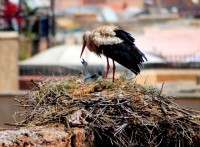


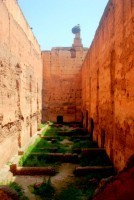

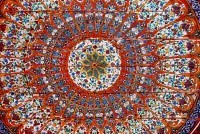
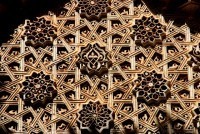
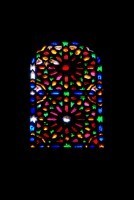
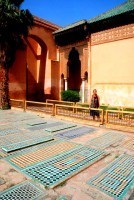
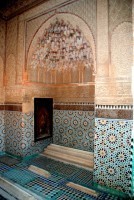
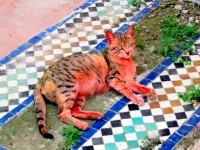
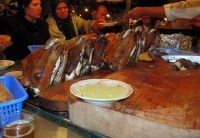
Blog post by Roderick Phillips, author of Weary Heart – a gut-wrenching tale of love and test tubes.
The post Saadian tombs, Marrakesh, Day 249 appeared first on Roderick Phillips.
April 3, 2014
Ali ben Youssef medersa, Marrakesh, Day 248
There’s a lot to see in Marrakesh and although Christi and I have now lost the ability to get up early we scuttle through the medina by mid-morning heading north of Djemma el-Fna to a cluster of three tourist attractions. The most impressive of these is the Ali ben Youssef medersa. The first challenge we face is actually finding the tourist sites. The alleys are poorly marked and it is easy to get disoriented in the endless souqs that cover the medina.
Despite the narrowness of the alleyways down which we trot, there is a plague of suicidal moped drivers zooming along the twisting, windy paths. They honk noisily at locals and tourists alike urging them out-of-the-way and leaving in their wake a plume of pollution that lingers menacingly.
Finally, after a few wrong turns we reach the 12th century Ali ben Youssef mosque which is closed to us non-believers, but adjacent to the mosque is the Ali ben Youssef Medersa (a.k.a. Ben Youssef Madrasa). This Koranic school dates to the 14th century and at one point was a major seat of learning in Marrakesh. Now the medersa is open to the public who come to marvel at the beautifully intricate stucco, cedar, and marble designs. The geometric patterns are exquisite, demanding to be photographed. We spend ages finding new designs, different angles, and ever-changing light to enthrall us. The main entrance of the medersa opens up into a courtyard with a central pool. To the sides are pillared archways. The second level is full of study rooms that overlook the courtyard and the exterior walls facing the square are a riot of stucco patterns. Absolutely amazing.
Outside the medersa a Berber woman selling silver bracelets pursues us with reckless abandon. She is dressed from head to toe in black, aside from her coal black eyes. Christi weakens and buys several trinkets, but I also persuade the Berber woman to let me photograph her. It’s a rare opportunity to photograph these women and I get one shot.
The 60D (US$8) ticket for the medersa also gives us access to two other tourist attractions in the area, the second of which is the Qoubba Almoravide. This is the oldest building in Marrakesh dating to the 12th century and is a classic example of Almoravid (an early Berber dynasty)architecture. Qoubba roughly translated means ‘dome’ and it is the decoration inside the dome that is most appealing. It is believed that this building was the ablutions area for the Ali Ben Youssef mosque. Last on our list of places to visit is the museum of Marrakesh located in the beautifully restored Dar Mnebhi palace. The palace itself is a good example of classical Andalusian architecture. Yet again there is a beautiful central courtyard with fountains, alcoves, beautiful geometric patterned tile work and elegant ceiling carvings. The museum holds exhibits of both modern and traditional Moroccan art, including an excellent series of photographs depicting Berber and Moroccan life during the 19th and 20th centuries. Moroccan art and architecture is simply superb.
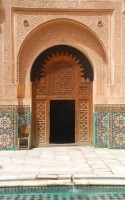
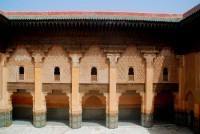
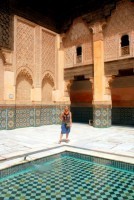
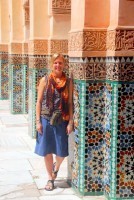
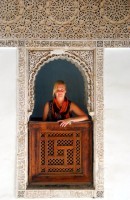
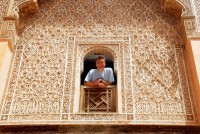
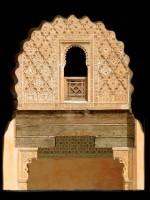

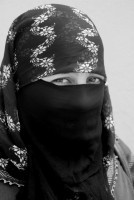
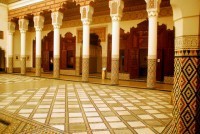
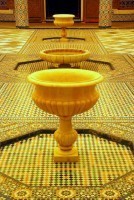

Blog post by Roderick Phillips, author of Weary Heart – a gut-wrenching tale of love and test tubes.
The post Ali ben Youssef medersa, Marrakesh, Day 248 appeared first on Roderick Phillips.
April 2, 2014
Marrakesh, Morocco, Day 247
Having experienced a transfer of prisoners and rowdy passengers on separate CTM buses between Dakhla and Essaouira, we defect to Supratours for the 3-hour ride to Marrakesh. Unfortunately the leg room aboard this particular Supratours bus is negligible and worst of all the damn bus breaks down less than 15 minutes after leaving Essaouira. Perhaps we weren’t supposed to leave Essaouira after all! Even more ironic is that we breakdown outside the same Argan oil cooperative, Marjana, that our taxi driver insisted we visit after photographing the tree-climbing goats a few days ago – bizarre. While some passengers seek alternative transportation, Christi and I wait 1 hour and 45 minutes for a replacement bus to continue our journey to Marrakesh. While we wait we spot a rare Moroccan desert tortoise nibbling on some fruit.
The place to stay in Marrakesh has got to be Djemma el-Fna, which is a massive square on the edge of the medina. The hotel we choose is, ironically, called the hotel CTM. I have to say I much prefer the hotel to the bus service. The prices are reasonable, the rooms are large and comfortable. The best part is the terrace overlooking the square. Breakfast is served here and what a view with which to eat your croissants.
Exploring Djemma el-Fna is a crazy experience. During the day snake charmers, youths with chained Barbary apes, henna artists, musicians, magicians, and some dubious games that you might see in a carnival (and which you have zero chance of winning) together with purveyors of dried fruits and fresh OJ vie for your attention (or more accurately your money). The snake charmers always seem to play the same strident tune on their pipes – perhaps its the only song the cobras and adders know. Truthfully, it’s quite sad to see the snakes and the Barbary apes being so mistreated and Christi and I purposely avoid any interaction with the street peddlers and for once don’t take photographs. Mind you our own PETA-like stand is not mirrored by the many other travelers and tourists who flock to the square, so no doubt these unseemly practices will continue.
As night falls the make up of the market changes and all manner of temporary food stalls are erected. As Christi and I wander around, we encounter some quite aggressive touts trying to tempt us to eat at their particular establishment. There are only so many times you can say no (something I think these restaurant provocateurs count on) before we too meekly agree to sit down and have dinner. Another traditional Moroccan dish that Christi is eager to try is harira, which is mostly lentils and chickpea in a tomato based broth. She’s also persuaded to try the local snails. Be warned Moroccan snails are ‘yucky’ – direct quote.
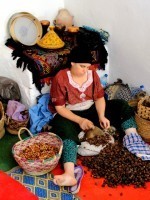
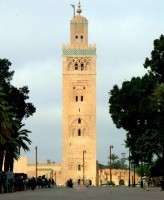
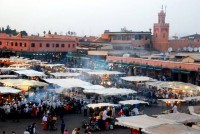
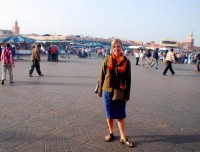

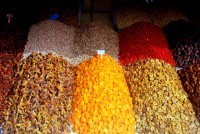


Blog post by Roderick Phillips, author of Weary Heart – a gut-wrenching tale of love and test tubes.
The post Marrakesh, Morocco, Day 247 appeared first on Roderick Phillips.
April 1, 2014
Essaouira: fortifications and architecture, Day 246
Sadly, this is our last full day in Essaouira. We have been here for 6 days and a wonderful sense of contentment has set in, which is a serious danger for travelers. Perhaps one of the key elements of traveling in a foreign land is that you are always uncomfortable because you are always getting lost and you don’t know how things work. By the time you’ve figured out these basic issues for each destination it’s usually time to move on and become uncomfortable all over again. I think the art of traveling is to make oneself comfortable in uncomfortable situations. And if you can’t do that then you’re probably not going to enjoy this type of adventure on a repeat basis. Is it possible that the reason Christi and I return to the Open Road on such a regular basis is that we get too comfortable in our daily lives? And such is the level of our contentment here in Essaouira that we barely make it to the rooftop terrace before the breakfast service ends at 10:30 am. Today, Christi and I are going our separate ways – at least for a few hours. Christi’s maniacal dedication towards uploading the hundreds of photos I’ve taken of late take to Picassa is very impressive. Perhaps less impressive from Christi’s perspective is that I’m going to spend another day photographing the medina and its surrounding fortifications.
The medina is a UNESCO world heritage listed city. It is an example of a late 18th century fortified town, built by European colonists. Frenchman, Thédore Cornut, designed and built most of the city (including the northern fortifications or ‘scala’), while the harbor entrance was built by an English renegade known as Ahmed the English (and no I’m not making that up) and the harbor citadel (or southern scala) was built by Genoese engineers. In addition to the fortifications, themselves, cannons (some of which are Dutch and date to 1744) still guard the city. It is remarkable to think that as recently as 1956 Essaouira was part of the French Protectorate of Morocco. Even now there are enclaves within Morocco – namely Ceuta and Melilla on the Mediterranean coast – that are administered by Spain.
Later, I rescue Christi from the internet cafe and show her some of the fortifications in the harbor and in the medina itself. In truth, though, she’s more excited by the dogs and cats we find. It’s been a great few days here in Essaouira but tomorrow we move on to the brashness of Marrakesh. Christi and I will miss this little slice of heaven by the sea.
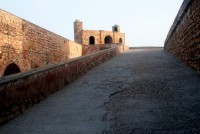

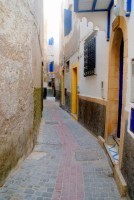

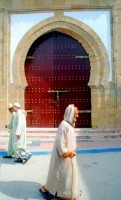

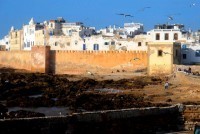
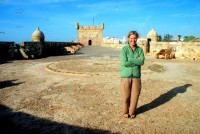
Blog post by Roderick Phillips, author of Weary Heart – a gut-wrenching tale of love and test tubes.
The post Essaouira: fortifications and architecture, Day 246 appeared first on Roderick Phillips.
March 31, 2014
Tree-climbing goats, Morocco, Day 245
Our original plan today was to take an early morning bus from Essaouira to the town of Smimou, an hour to the south on the road to Agadir. Supposedly Smimou is the center of the tree-climbing goats phenomenon – if you believe in tree-climbing goats (and I mean unaided by alcohol or hallucinogenic drugs). Unfortunately, we are in danger of missing out because Christi is having another of her semi-frequent bouts of nausea and remains in bed and rather subdued. I force her to dig into her bag of pharmaceuticals and take some of the drugs she’s always prescribing me. Reluctantly she complies and by lunch time her condition has improved sufficiently that finding tree-climbing goats sounds a lot more fun.
The problem now is the erratic and infrequent bus service to Smimou. We may be able to reach Smimou today, but there’s little chance of us returning to Essaouira tonight. We plod around the medina instead, until I come up with the bright idea of hiring a taxi (if cheap enough) to just find the damn goats for us. We eventually stumble across an English-speaking taxi driver who assures us categorically that for 250D (about US$30) he will find tree-climbing goats. His confidence does not stretch to a money-back guarantee, however. I don’t think the phrase ‘money-back guarantee’ is a popular phrase in Arab cultures. Still US$30 is a good deal and at least we will be searching for goats from the relative comfort of a taxi as opposed to another derelict bus.
The countryside around Essaouira is very pretty; classic Mediterranean scenery with Argan trees (almost endemic to Morocco) being a common sight. Argan trees are gnarly with quite vicious thorns to protect their fruit. And it is the fruit, or more accurately, the seed that gives rise to the famous Argan oil (used for both culinary and cosmetic purposes). Christi and I are fortunate to be in Morocco in the spring when the whole area is awash with wild flowers: from red poppies to white daisies, yellow buttercups and mauve violets not to mention meadows of lush green grass. We also see more camels – some of which are being ridden along the beach (you can’t escape camels in Arab Africa), together with an abundance of donkeys and sheep. Of the goats, though, there is no sign. Our driver looks increasingly worried and continually stops to chat to the locals. Based on those conversations we zoom off enthusiastically in new directions, but still no goats. We are beginning to think our search will end in failure when our taxi driver finally locates a herd of the acrobatic little chaps happily munching away in a grove of Argan trees (both leaves and the fruit are tasty delicacies). Christi and I spend a happy 30 minutes snapping away at the dexterous little devils who seemed unperturbed by our presence.
Having witnessed the phenomenon of the tree-climbing goats Christi and I are happy to return to Essaouira, but our taxi driver has other ideas. He is determined that we should visit an Argan oil cooperative. These cooperatives are as popular around Essaouira as wineries are in Napa. Oil is recovered by hand from the Argan nuts and then incorporated into all manner of products for putting on you and in you. We weaken and buy some quite expensive soap. One thing is for sure, by the time we leave Essaouira we will be clean!
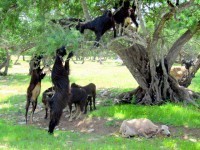

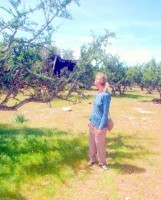
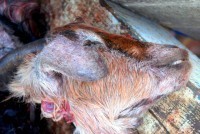
Blog post by Roderick Phillips, author of Weary Heart – a gut-wrenching tale of love and test tubes.
The post Tree-climbing goats, Morocco, Day 245 appeared first on Roderick Phillips.
March 30, 2014
The Atlantic Coast at Essaouira, Day 244
Sadly, the introductory rate on our hotel suite is over, so we’re moving to a less glamorous double room (without TV) for 350D (US$45) per night for the remainder of our stay. Don’t forget our daily budget for the whole trip is still only US$100 so any savings Christi and I can make on the accommodation gives us more money to spend on food and activities. What does not change is the delightful rooftop breakfast. The freshly squeezed OJ and freshly baked croissants really are delicious.
The location of the medina hard up against the Atlantic Coast is a stunning setting. Waves crash upon the exterior walls of the fortifications, which protect the white-washed buildings within. This location is a photographers’ dream. I want to spend at least part of the day finding the perfect image of the Medina and the Atlantic Coast, although Christi insists on finding an internet cafe with a fast connection first so she can upload the hundreds of photos I’ve already taken over the last few weeks. While Christi works, I surf the net:checking out the latest English football gossip, making sure we still have some money in our bank account, and, of course, planning the next stage of our Year of Wonder.
We eat a late lunch at the Disney-esque Ali Baba’s. It’s everything a tourist could want in a Moroccan restaurant – aside from the flying carpet. And despite this, the lamb tajine is surprisingly tasty. As we search the medina for those perfect Kodak moments, we come across the ticket office for the Supratours bus service to Marrakesh and reluctantly purchase tickets. We won’t be leaving quite yet, but whereas Essaouira (pronounced Essa-weera by the way) is a quiet idyll, Marrakesh is a major tourist center – reputed to be loud, brash, and in your face. How on earth will we cope with such a tourism frenzy and more importantly how will we survive without OJ and croissants?
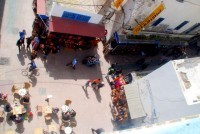
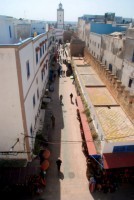
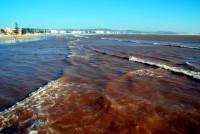
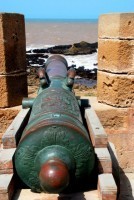
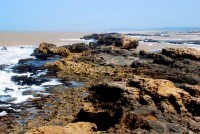
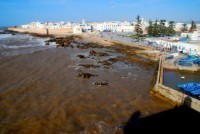
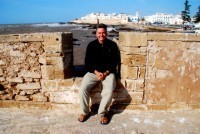
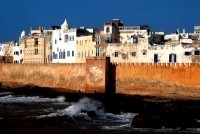
Blog post by Roderick Phillips, author of Weary Heart – a gut-wrenching tale of love and test tubes.
The post The Atlantic Coast at Essaouira, Day 244 appeared first on Roderick Phillips.
March 29, 2014
Hammams and fishing boats, Essaouira, Day 243
One of the things to do while in Morocco is to visit a hammam (or Turkish bath). For 80D (US$10) your body is scrubbed brutally clean. And both Christi and I are in dire need of a deep clean after our adventures in Mauritania. We have sand…well, everywhere. And I mean everywhere! Typically hammams set aside separate times for male and female bathing, but such is the power of tourism, couples’ hammams have begun to spring up in Morocco so Christi and I can be scrubbed clean together. The staff at the Dar Mounia hotel recommend an establishment off the beaten track, which takes us an age to find. The place must be fairly authentic because no one speaks English. Consequently, there is some confusion as to what – if any – clothes we will be wearing and who will be scrubbing us. We’re taken to an ante-room to change. We strip to our underwear to retain a modicum of decency and are then escorted to a tiled, heated room reminiscent of a sauna. The floors are heated, there is condensation on the walls and ceiling, and the floor is also wet. We are encouraged to lie down on our backs and I for one feel rather exposed with only my briefs to spare my blushes. As I lie there all manner of…interesting thoughts occur to me. I’m not that comfortable with strangers of either sex touching me, but the prospect of being bathed by a drop-dead gorgeous woman has me sweating a bit…
A reassuringly plump, middle-aged woman enters our bathroom and I sigh with relief. Christi rolls her eyes. Apparently she is comfortable with anyone touching her naked body. The middle-aged lady fills a bucket with hot water from a sink in the corner of the room and douses Christi. She follows this up with lathering Christi in black Argan oil exfoliating soap. Every inch of Christi’s exposed flesh, including her breasts are soaped. I watch with amused interest. Then it’s my turn. I’m doused and soaped in the same way. The woman speaks to us in Arabic and we nod, although we have no clue what she said. She then leaves the room and we’re both left to stew for 30 minutes.
On her return she brings some scouring pads and immediately goes to work on Christi’s tender body. The dead skin and dirt that rolls off my beloved is quite disconcerting, although mine is even worse. It is mildly painful, but by the time the woman has finished scrubbing and scouring we have soft squeaky-clean bodies. We look cleaner and cuter than a Gerber baby!
We soon ruin all that good work, however, by walking along the beach. The wind in this town is definitely bracing and it whips up the sand, covering us in dirt again. It’s a very pleasant, if windy, walk with bikini-clad tourists lying next to Moroccan woman covered from head to toe. I can’t imagine it’s a very pleasant beach experience for the Moroccan ladies. Later we return to the fish market, where we had lunch on our first day, and from there to the docks where the catches are brought ashore and the fishing boats are maintained. We watch in fascination as nets are fixed, boats undergo repairs, and the fish are gutted. We satisfied our craving for clean skin earlier today, now it’s time to satisfy our stomachs.
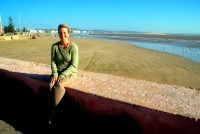

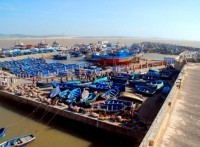

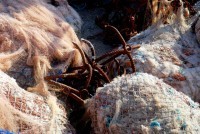
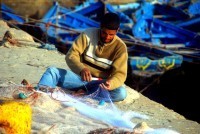

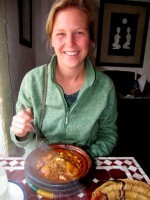
Blog post by Roderick Phillips, author of Weary Heart – a gut-wrenching tale of love and test tubes.
The post Hammams and fishing boats, Essaouira, Day 243 appeared first on Roderick Phillips.
March 28, 2014
Medina, Essaouira, Day 242
In addition to the wonderful suite Christi and I are enjoying at the Dar Mounia hotel located in the heart of the medina in Essaouira, the US$60 per night room rate comes with a free breakfast. Breakfast is on the rooftop overlooking the medina. The freshly brewed coffee, freshly squeezed orange juice, and freshly baked croissants are a taste sensation. Spiky sea urchin goop may not be my thing, but I could drink OJ and eat croissants all day. And we have the rooftop to ourselves. I’m not entirely sure if there are other guests in the hotel or perhaps it’s the lateness of the hour (they finish serving breakfast at 10.30 am and we barely made it in time).
We saw bits and pieces of the medina yesterday, but today we poke around in earnest. There are several things that become apparent immediately. First, the medina (yet another world heritage site) is not awash with litter – someone actually goes to the bother of cleaning the streets each night (I like that). Second vehicles are not allowed in the medina. In truth some of the thoroughfares are little more than alleyways so cars wouldn’t even fit, which is why donkey and carts and wheelbarrows abound. Third, picture-taking is not regarded as one of the seven deadly sins, which is also a relief. Fourth, we are surrounded by tourists and as I mentioned yesterday tourists = conveniences. And modern conveniences have been sadly lacking of late. Our hotel has lashings of hot water and we take ridiculously long showers; we watch satellite TV (even if the program isn’t in English); we gaze at the trillions of trinkets and souvenirs for sale in the medina (we have no desire to purchase any of them, but it’s comforting to know they exist); even the pubs show English football and offer full English breakfasts (not very Moroccan, I know, but damned appealing nonetheless). It’s amazing how such simple things can bring a tear to my eye and once again begs the question of whether I’m really cut out for adventure travel, after all.
It’s been my experience that medinas, souqs, and bazaars all have certain things in common. First you will get lost, but in truth that’s half the fun. There’s always a way out of course, just not where you hoped. Second there are many opportunities to spend money (food, souvenirs, clothing etc.). Third the stallholders are all very good salesmen who often speak numerous languages. And fourth it is virtually impossible to leave the medina without buying something; the locals won’t let you! Indeed, Christi buys some sandalwood essence from one of the numerous perfumeries. Is it mere coincidence that Christi is currently re-reading the classic Tom Robbins novel, Jitterbug Perfume?
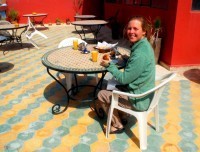

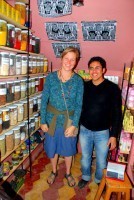
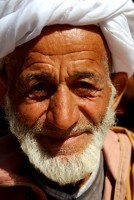
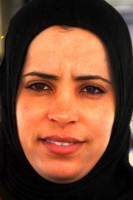
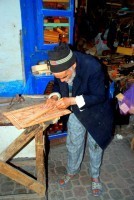
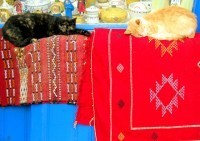
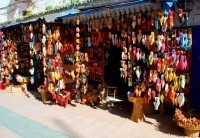
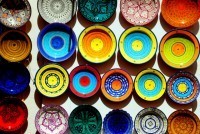
Blog post by Roderick Phillips, author of Weary Heart – a gut-wrenching tale of love and test tubes.
The post Medina, Essaouira, Day 242 appeared first on Roderick Phillips.
March 27, 2014
Essaouira, Morocco, Day 241
Our initial plan had been to make the long journey north from Dakhla in Western Sahara to Essaouira in Morocco over two days with an overnight stop in Laayoune. This would therefore avoid another miserable overnight bus trip (Christi and I had endured enough of those in South America). However on reaching Laayoune there seemed little point getting off the bus. Christi’s unruly bowels were behaving well enough, plus we had no idea where to stay or how to arrange our onward transportation tomorrow morning. The prospect of yet another uncomfortable night on a bus is not that appealing, but the carrot dangling just out of reach is a long, relaxing stay in the fishing port of Essaouira. It means being back on the tourist trail, which means (even more so than Dakhla) convenience and services (and no doubt a few hawkers). We bite the bullet and jump back on the bus.
Moroccan buses are nothing like those delightful Andesmar vehicles we experienced in Argentina. As I mentioned before Moroccan buses do not have toilets onboard, nor do they offer a meal service, and worst of all the seats barely recline. The space is limited and it is impossible to stay comfortable, which is a challenge considering we’re on this CTM bus for another 12 hours (in addition to the 9 hours we have done so far). Perhaps the most annoying thing is that the bus continues to stop for bathroom breaks and meal stops. The countryside changes as the dawn breaks as we finally exchange the desert for the mediterranean. We arrive in Agadir at 7.30 am. We stay in this large coastal resort town for as long as it takes to catch the first bus on to Essaouira. Considering we have just spent 20 hours in a bus (longer than any of our South American bus rides note) Christi and I feel not too bad. The 8 am bus to Essaouira is a complete rust bucket, something you’d expect to see in Bolivia rather than Morocco. This has to be the lowest class of bus. The driver is a maniac who appears to care neither for his own safety nor that of his passengers. Mind you the passengers are a rum lot. One, sitting across the aisle from us appears to be having a bad reaction to whatever illegal drugs he’s using. He’s loud and obnoxious and almost gets into a fight with the bus conductor. The crazy driving also provokes an avalanche of vomit (fortunately into bags) which are then tossed out the window. God forbid you’re at the back of the bus and are looking out the window! If there was time to experience the views, then they are quite idyllic. We speed through pretty little villages, dice with death on the bluffs overlooking sweeping vistas of Atlantic ocean, while inland we see an explosion of wildflowers in the foothills of the Atlas Mountains.
Everyone is relieved to arrive in Essaouira after 3 miserable hours and exactly 24 hours since Christi and I left Dakhla. Without doubt we have earned a long relaxing break in this idyllic seaside town. And an army of touts board the bus before we can even get off. The only way to avoid confrontation is to choose one to help us. We explain to our new fixer exactly what we want and he races off into the maze of streets that comprise the medina, the heart of Essaouira. It’s also possible to rent a wheelbarrow and driver to cart your luggage around (the medina being largely free of traffic) so all of us are chasing after our fixer. We actually walk for some 15 minutes before reaching the Dar Mounia hotel deep within the medina. To our complete amazement we are given a two-room suite for 500 Dirham (US$60) per night. At last, after months on the road, Christi and I get to relax – which is not the same as doing nothing.
We begin by visiting the water front where our Lonely Planet guidebook promises us a seafood feast. Christi appears to have recovered from her dodgy tummy in Dakhla because she is eager to sample the large selection of freshly caught fish and shellfish from any number of stalls. Whatever you select is immediately barbecued and served in minutes. It does not get much fresher than that. Christi is drawn to the sea urchin, which is bright orange in color and slimy on the taste buds. As usual Christi pronounces it de-licious. I on the other hand am trying not to gag. Later I decide to get a haircut and cut-throat razor shave in the medina. This is my first haircut on this African leg of the trip. Haircuts in African are risky from an aesthetic perspective. A few years ago I went to a barber in Victoria Falls (Zimbabwe) who offered haircuts for only 50 cents. How could I go wrong. It must be the cheapest haircut in the world. I guess an alternative view would be: you only get what you pay for. The barber knew how to use clippers, but not scissors. Consequently the only cut he knew was the buzz cut. I had no desire to look as if I was in the military so I took my half-finished haircut to an expensive salon in the Victoria Falls Hotel and paid lots of money to rescue my luscious locks. I’m glad to say the barber of Essaouira was a skilled artisan and I now have an immaculate haircut to go with my immaculate good looks. God I think I must have inhaled some of whatever that bus passenger was consuming. Time to retire to our deluxe accommodation. Our bedroom has 3 beds. What are we going to do with 3 beds, let alone a couch and a TV that has English-speaking programming. I think Christi and I have died and gone to travelers’ heaven.
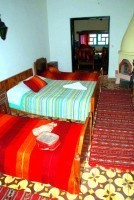
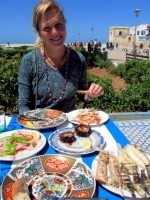
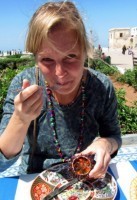
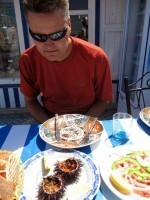


Blog post by Roderick Phillips, author of Weary Heart - a gut-wrenching tale of love and test tubes.
The post Essaouira, Morocco, Day 241 appeared first on Roderick Phillips.

